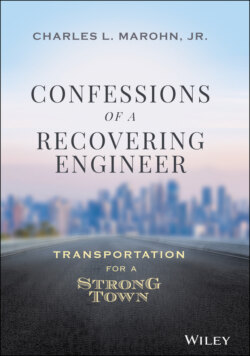Читать книгу Confessions of a Recovering Engineer - Charles L. Marohn Jr. - Страница 9
Hidden Values
ОглавлениеThat night Sagrario Gonzalez made fateful decisions about how to navigate an environment where her existence was, at best, an afterthought, and at worst, a nuisance. The options she had available to her were the result of the underlying values applied to the design of State Street — values reflected in similar environments across North America and wherever around the world American design practices are being emulated.
The professionals who design streets follow a practice codified in the decades since the Great Depression. Engineers who do this work learn it as a practice, as a body of technical knowledge that has been amassed over generations. While one book or another of engineering standards is often referred to as “the bible” by those who use them, that reference is due more to their centrality to the practice of engineering than to the type of wisdom imparted.
While the religious debate passages of the Bible, contrasting different teachings in a search for deeper truth, the codes of an engineering manual are more like a cookbook. If you wish to make a certain type of chocolate cookie, a cookbook will provide the common ingredients found in cookies and the specific way to arrange them for a particular recipe. Likewise, if you wish to build a certain type of street, an engineering manual will explain the way to assemble all of the components so that you get the desired outcome.
What is expected in a religious text, but not in a cookbook, is deeper meaning. Few people question the underlying values contained in a fruit salad recipe. None search for hidden truth in the list of ingredients for a souffle. The recipes in a standard cookbook do not have an underlying ideology or belief system attached to them. A cookbook is viewed as value free. It is merely instructions for assembling ingredients into finished foods.
Transportation professionals consider their texts, and by extension their entire profession, as being similarly value free. This is wrong.
At the foundation of traffic engineering is a collection of deeply infused values. These values are so deep, and so core to the profession, that practitioners do not consider them values. They bristle at the suggestion. For practitioners, these values are merely self-evident truths — something like gravity that it is not necessary to believe in because it just is.
These values are expressed in the range of options that engineers consider, the way that they discuss different approaches, and the transportation systems that they build. This would not be a problem, and we could allow this entire profession to retain their sacred texts and practices unchallenged by heretical viewpoints, if they could find a way to address the damage traffic engineering is doing to our communities.
They cannot do this for a simple reason: The damage being done is the culmination of those values. The injuries and deaths, the destruction of wealth and stagnating of neighborhoods, the unfathomable backlog of maintenance costs with which most American cities struggle, are all a byproduct of the values at the heart of traffic engineering. Addressing the damage requires addressing the values, but you cannot address something that you deny even exists.
The underlying values of the transportation system are not the American public's values. They are not even human values. They are values unique to a profession that has been empowered with reshaping an entire continent around a new, experimental idea of how to build human habitat.
Let us identify those values.
